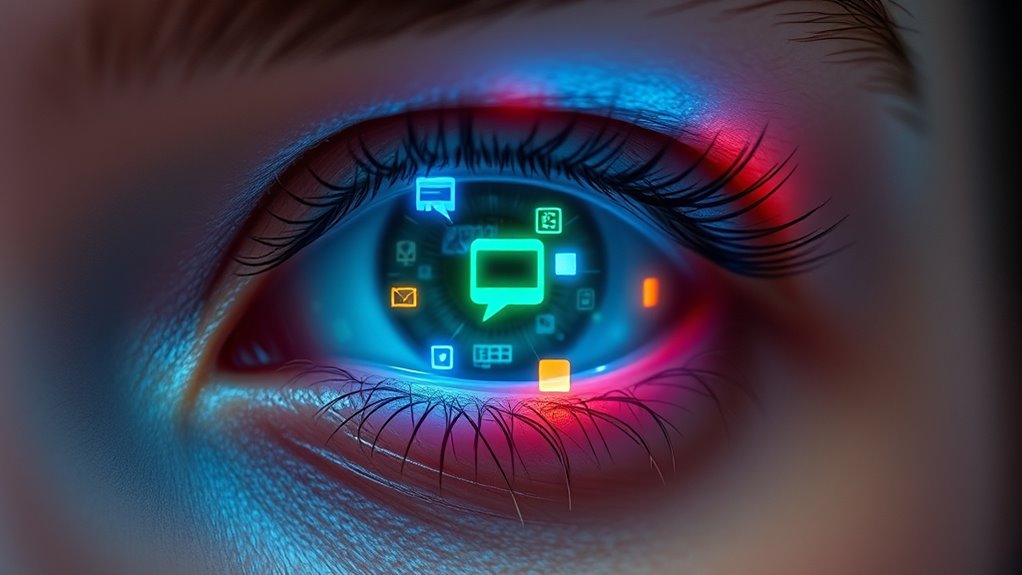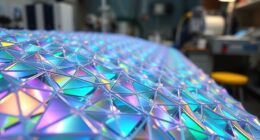Augmented reality contact lenses are innovative devices that project digital images directly onto your eyes, blending virtual content seamlessly with what you see naturally. They contain micro-displays, sensors, and wireless tech, allowing you to access information, notifications, or navigation without straining your eyes or holding devices. Designed to keep your vision unobstructed, these lenses respond to eye movements for easy control. If you’re curious about how this futuristic tech works, keep going to uncover more details.
Key Takeaways
- AR contact lenses project digital images directly onto the cornea, overlaying information onto natural vision seamlessly.
- They incorporate micro-displays, sensors, and wireless technology for real-time data and biometric monitoring.
- Display resolutions start around 640×360 pixels, with future aims for HD or 4K quality visuals.
- Control mechanisms often rely on eye movements and blinking for hands-free interaction.
- Manufacturing challenges include miniaturization, power management, comfort, and ensuring biocompatibility.

Augmented Reality contact lenses are a groundbreaking wearable technology that seamlessly overlay digital information onto your natural vision. Instead of bulky glasses or headsets, these lenses integrate micro-displays, sensors, and wireless connectivity directly into the lens material, offering a discreet and convenient alternative. Inside each lens are tiny screens and processing chips capable of projecting images onto your cornea, creating the illusion of virtual content blended perfectly with your real-world view. The display technology can include LED or micro-OLED screens, sometimes near-eye projected rather than fully embedded, all designed to keep your natural sight unobstructed while adding digital layers.
Augmented Reality contact lenses project digital images onto your eye, blending virtual content seamlessly with real-world vision.
These lenses aim to provide a seamless experience, making digital information feel part of your environment. Early prototypes display resolutions around 640×360 pixels—comparable to a small screen viewed from a distance—but the goal is to reach HD or even 4K quality soon. They are equipped with environmental and health sensors that analyze your surroundings and monitor biometric data, like tears, for health insights. Control mechanisms for interacting with the AR content often rely on eye movements and blinking, allowing you to command the device naturally without needing external controllers. Wireless connectivity enables real-time updates, notifications, navigation cues, language translation, and virtual interfaces to appear instantly in your line of sight. Advances in nanotechnology and materials science are crucial for overcoming these obstacles and enabling mass production.
Compared to traditional AR devices, these contact lenses are more ergonomic and lightweight, eliminating the bulkiness of glasses or headsets. Their discreet design means you can wear them throughout your day without attracting attention or feeling uncomfortable. Because they overlay information directly onto your vision, they enhance your natural sight without blocking peripheral views or requiring separate screens. Some models combine vision enhancement and health monitoring functions, giving you both digital augmentation and biometric insights in one device. They promote hands-free, heads-up display capabilities, providing instant access to digital content without interrupting your natural flow or focus.
However, developing such tiny devices presents considerable challenges. Miniaturization of displays, batteries, and sensors into a safe, comfortable contact lens is complex. Power management becomes a concern, as small batteries limit how long you can use the lenses before needing a recharge. Achieving high-resolution, bright displays visible under varying lighting conditions remains difficult. Ensuring biocompatibility, comfort, and a proper fit for diverse eye shapes demands advanced materials and manufacturing precision. Additionally, integrating wireless data transmission without interference or harm poses technical hurdles. Advances in nanotechnology and materials science are crucial for overcoming these obstacles and enabling mass production. These innovations are also essential for making the technology affordable and accessible to consumers worldwide.
Current prototypes, like Mojo Vision’s lens, feature embedded micro-displays, cameras, and antennas. Mojo’s lens can project images directly onto the fovea, following your eye movements like a miniature spotlight. Despite these advancements, commercial availability still faces hurdles, but the potential for these lenses to revolutionize how you see and interact with digital information is undeniable.
Frequently Asked Questions
How Long Do Augmented Reality Contact Lenses Typically Last?
You’re wondering how long AR contact lenses last, but since they’re still in prototypes, there’s no set lifespan yet. Development is slow, and regulatory hurdles like FDA approval delay real-world use. Factors like material durability, battery life, and heat management influence wear time. Early versions might need frequent replacements, similar to daily or monthly contacts. As technology improves, expect longer wear periods, but precise durations remain uncertain until commercial products hit the market.
ARe AR Contact Lenses Safe for Everyday Use?
Are AR contact lenses safe for everyday use? Well, if you enjoy eye strain, dry eyes, and occasional dizziness, then sure! But honestly, they carry risks like eye discomfort, distraction accidents, and privacy breaches. You’ll need to blink more, take frequent breaks, and stay aware of your surroundings. Until we get more research, it’s best to approach these high-tech lenses with caution, not reckless enthusiasm.
What Is the Cost Range of AR Contact Lenses?
You’re probably wondering about the cost of AR contact lenses. Right now, they’re estimated to be around $1,500 per pair, similar to high-end smartphones. Although prices vary depending on features and application, early models tend to be premium-priced. As production scales and technology improves, expect prices to drop, making them more affordable for everyday use. Regional markets and competition will also influence the final costs over time.
Can AR Contact Lenses Be Customized for Individual Vision Needs?
You can absolutely customize AR contact lenses for your specific vision needs. Manufacturers mold the lenses to fit your eye shape precisely, ensuring proper alignment and comfort. They embed prescription correction, color enhancement, or other features tailored to your conditions. Advanced tech like micro-LEDs and sensors adjust display content based on your eye movements, making these lenses highly personalized and effective for improving your vision and AR experience simultaneously.
How Do AR Contact Lenses Impact Eye Health Over Time?
When it comes to your eye health over time, don’t throw caution to the wind. AR contact lenses are made from biocompatible materials, but prolonged wear can cause irritation, dryness, or even eye strain. If you don’t follow proper hygiene and usage guidelines, you risk infections or oxygen deprivation. Staying informed, practicing good hygiene, and taking breaks will help you keep your eyes healthy while enjoying the tech’s benefits.
Conclusion
Imagine stepping into a world where your eyes become windows to endless information, like having a personal, invisible universe built right into your vision. Augmented reality contact lenses turn your everyday sight into an intelligent landscape, seamlessly blending digital and real worlds. As these lenses evolve, they’ll be your compass, guiding you through life’s adventures with clarity and precision. Soon, your eyes won’t just see — they’ll narrate the story of your connected world, effortlessly.










